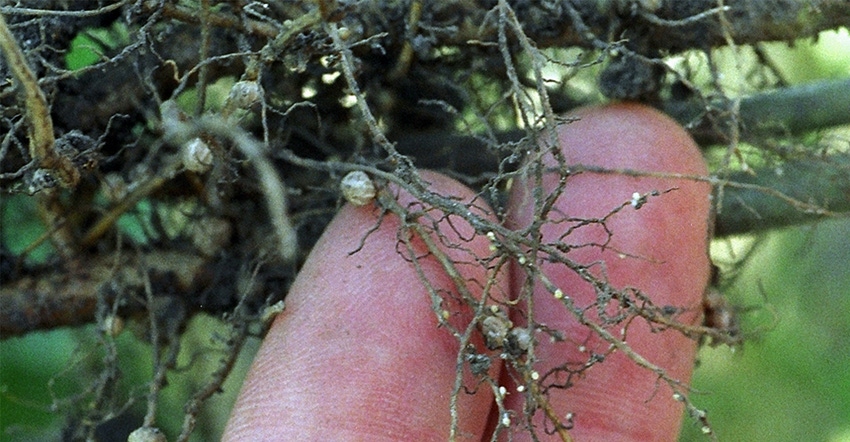August 15, 2017

The 2017 crop season hasn’t been very much fun so far. After starting out cold, wet and ugly for a lot of us, Mother Nature did a 180. As of early August, two-thirds of the state was suffering from drought. Now we can just hope that when we get caught up on moisture, it isn’t during harvest or during soil sampling season. That’s right. Most of you — maybe up to 70% — need to have more soil samples taken this fall.
I hate to “pile on” more bad news on top of our struggles with weather this season, but a recently published research paper caught my attention in light of the hot and dry weather we had. Iowa State University researchers analyzed 25 years of data, from tens of thousands of variety evaluation research plots, to look for long-term trends. The results, published in the article “Increase in Soybean Cyst Nematode Virulence and Reproduction on Resistant Soybean Varieties in Iowa from 2001 to 2015 and the Effects on Soybean Yields” in the scientific journal Plant Health Progress, showed a breakdown of resistance in SCN-resistant varieties.
The entire paper is worth reading, but a statement I saw in the opening paragraph is what caught my attention: “SCN population densities were positively correlated with temperatures and negatively associated with precipitation during the growing seasons, indicating that SCN reproduction was greatest in hot, dry years.”
Knowing your SCN numbers
This means the approximately 70% of Iowa fields that have SCN will likely suffer not only this season, but future seasons as well. This year, especially in the drier regions, yield losses from SCN will be higher than normal. They simply steal more yield from soybeans under stress. Rubbing salt into our wounds, the second part of the equation is the increased reproduction in years like 2017; SCN pressure will increase dramatically in many fields heading into 2018 and beyond.
That’s why we want to help minimize the long-term impact from increased SCN numbers. To do that, you absolutely have to know what those levels are across your fields, and soil sampling is the only way to find out.
Sample fields of soybean stubble this fall to see what the SCN numbers climbed to in 2017 so you can implement the right strategies for the next time those fields head into soybeans. Soil-sampling cornstalk fields heading into soybeans next year is also a must. We have to know what sort of SCN numbers might be there waiting for the new soybean crop.
Symptoms more visible in stress years
Probably the only good thing the drought has done for us is that it can make finding SCN, especially hot spots, a little bit easier task. SCN damage often flies under the radar by showing few, if any, aboveground symptoms most seasons. Yes, nematodes cause plant injury and yield loss in “normal” years, but good weather masks the symptoms, and the yield loss is often attributed to something else or just chalked up to “variability” across a field. In years with stressful conditions, especially drought, aboveground symptoms are more likely to show up.
Stunting and yellowing of beans are typical aboveground symptoms of SCN, and early maturity of fields is another common and indirect aboveground symptom of SCN. While there are other soybean issues that can cause similar symptomology, this year it’s a good bet that SCN could be a primary culprit. SCN populations can vary a lot across fields, and often there are “hot spots.” If ever there was a year where something that visual was going to show up, I’d think it would be 2017, given that two-thirds of the state is so dry. Drop a GPS pin, or an old school field flag, in these areas so you can get a separate set of samples from them as you have the rest of the field sampled. Unusually low-yielding areas (relative to the rest of the impacted yields in fields due to weather stress) on harvest maps are likely candidates this year, too.
Fall good time to sample soil for SCN
With some of the state getting timely moisture, there will be areas where SCN still had good conditions for reproduction, while there are few, if any, aboveground symptoms. The bottom line is because SCN is widely distributed in Iowa, any field that soybeans are grown in should be checked for presence of SCN, whether we see symptoms or not.
While you can soil sample for SCN about anytime the soil isn’t frozen or muddy, fall is a perfect time to do it. Since it is a lot like sampling for soil fertility, many retailers offer ways to combine SCN sampling with fertility sampling. If you want to do an early fall spot check on a few areas that look suspicious before going all in, double-check with a few labs to find out what turnaround time is on samples.
My bet is that a lot of “spot checks” will come back positive for SCN. We’ll want to get any of these spot-check samples taken early and get results back quickly to take advantage of good fall weather windows to sample the remainder of our fields. More information about soil sampling for SCN is available in this ICM News article.
Sure, it’s a little bit like taking life’s lemons and making lemonade, or maybe more like taking chicken manure and trying to make chicken salad, but we have to take advantage of this one opportunity an otherwise generally disappointing crop year is offering. Work with your service provider to get a SCN sampling plan put together and get as much of it completed this fall as the weather allows. Good luck and have a safe harvest season.
McGrath is the On-Farm Research and Extension coordinator for the Iowa Soybean Research Center at ISU. Contact him at [email protected].
About the Author(s)
You May Also Like






